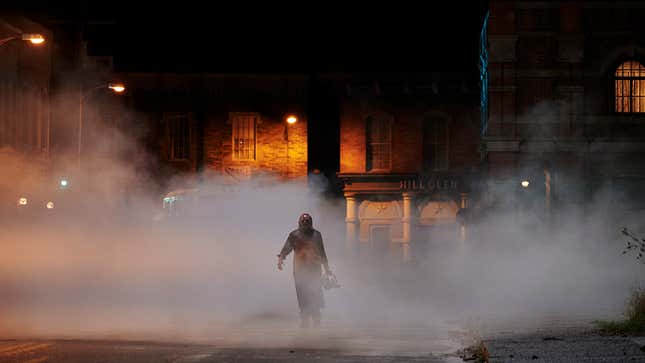A Socially Conscious ‘Texas Chainsaw Massacre’ Can’t Quite Hack It
The Netflix requel grafts gentrification and school shooting onto the franchise's decaying face.
EntertainmentMovies

Tobe Hooper’s original The Texas Chain Saw Massacre is such a viscerally repugnant movie, you can practically smell it. Before the chains buzz and slice in the 1974 drive-in classic, there’s grave robbing, an extended conversation about slaughterhouses and headcheese, feathers and bones as home decor, and an overall pukey ‘70s visual aesthetic. (Reports from the non-air conditioned set suggest it indeed stunk.) People scream and flail as a matter of course, not just when they’re being chased by murderous backwoods cannibals. It’s situated in America’s heartland, and yet there’s an alienness to the way people communicate in that movie—none of it smells right.
Well, you can’t rebottle stink, and that’s been proven time and time again in the mostly failed attempts to make a viable franchise out of such a singular vision. Aside from the serviceable 2003 remake (which ditched the space between the Chain and Saw) and the bonkers 1986 sequel, which Hooper directed into a horror-comedy left turn, little of note has come out of the endeavor to continue the story of Leatherface and his feral family in the past five decades and eight movies. Some day trips through hell are meant to stay day trips.
But since the requel machine demands content that is the same but different (with no designating numerals at the end of titles), we now have for our, er, enjoyment Netflix’s Texas Chainsaw Massacre. Directed by David Blue Garcia and produced by Fede Álvarez and Rodo Sayagues (the director-writer team responsible for 2013’s hilariously disgusting Evil Dead remake), this new Chainsaw is moderately more socially conscious and decidedly gorier than the original, to which it purports being a direct sequel. This one is better than most of the franchise’s other entries in the way that getting a hand sawn off is better than losing a leg. So barely, but the bar is so low that those looking to have a dumb good time watching dismemberment could do far worse. Progress comes in increments.
-

-

-

-

-

-

-

-

-

-

-

-

-

-

-

-

-

-

-

-

-

-

-

-

-

-

-

-

-

-

-

-

-

-

-

-

-

-

-

-









































